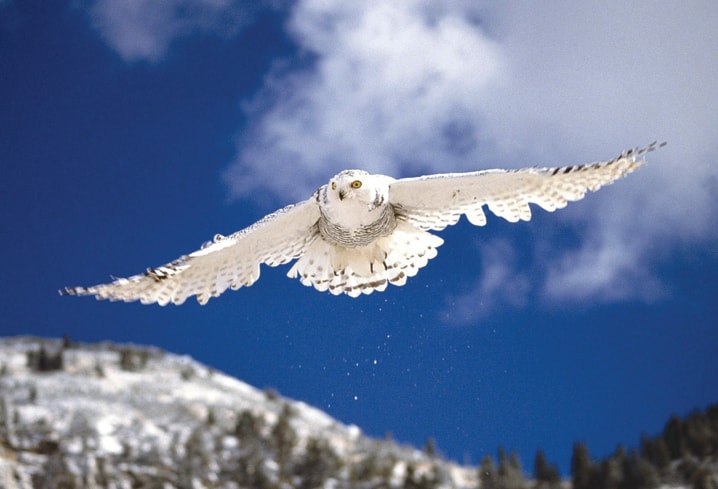There is a group of us birders who go out birding every Monday from September to May.
We meet at the Kerry Wood Nature Centre at noon (usually) and head out from there. We never really know ahead of time where we are going. It all depends on the birds.
If I’ve heard of a rare bird in the area, we’ll go there to see if we can see it. Otherwise, we just go where the mood takes us. Sometimes we walk an area but more often than not, we just drive around. If it’s exceptionally cold, we try to find people with feeders where we can impose and sit in the warmth of their kitchen watching the birds outside. This past week, we got to see a Snowy Owl, very near Penhold. He or she was just sitting on a telephone pole along Highway 42. I’ve already seen a couple of these owls already this year but it was a first for several of the people in our group. They were excited, let me tell you.
Snowies are our heaviest owls, coming in at four pounds. They are such beautiful birds. Females and juveniles of both sexes are darkly barred overtop of the white. Females keep the dark barring throughout their lives while the males get whiter as they get older. Some males can be almost pure white. It’s hard to tell the difference between a female (adult or juvenile) and a juvenile male because both have the barring.
I had thought for awhile that the whiter the face, the more likely it was a male but that is not the case. All of them, regardless of their sex have a white face. Young males tend to have a white bib under their “chin” and the back of their head is white. The Cornell Lab of Ornithology tells me that they also have “ fewer rows of bars on the tail than females.” I can honestly say I’ve never actually counted the bars on the tails so I can’t vouch for that as a field mark.
Whenever I’m writing these articles, I find that I often learn something I never knew before.
Snowy Owls eat predominantly lemmings. But they will at times, eat other things, one of which is geese. Now comes the part that I didn’t know about. Up in the arctic tundra, the Snowy Owl starts nesting before the geese come back. The Snow geese arrive and will place their nests close to where the snowy is nesting. Frances Backhouse in Owls of North America says “Researchers have found as many as 23 goose nests surrounding a single snowy owl nest, including one that was only 13 steps away from the owl’s quarters.” The reason for this? Arctic foxes like to eat geese and goslings. The Snowy Owl will attack and drive away anything that it perceives as a threat to its own eggs or young; thereby driving them away from the geese nests as well. Backhouse continues by saying, “Studies have shown that snow geese that nest within 600 yards of a snowy owl nest have a much higher breeding success rate than those that nest farther away.” Obviously this is clearly a situation that benefits the geese, but what does the snowy get out of it? Unfortunately we don’t get to see Snowy Owls here all the time. They spend most of their time in the open tundra of the arctic. We only get to see them in the winter. But they are an “irruptive” species, meaning that they appear around here in some winters but not in others.
Luckily, this seems to be one of those winters where there are quite a few of them around.
Hopefully on our Monday birding we’ll be able to see more Snowy Owls like the one we saw near Penhold.
I’m sure that we’ll also see lots of other great sightings before spring rolls around. By the way, you don’t have to be a member of our “group” in order to join us. Everyone is welcome on our Monday birding treks. Just be prepared to spend the afternoon. We usually stay out till dark. Bring along coffee and snacks for yourself, binoculars, favourite bird guides, and dress for the weather.
It’s nice to know beforehand if you’re coming so give me a call the day before. You can leave a message on the RDRN answering machine (403-347-8200).
Judy Boyd is a naturalist with the Red Deer River Naturalists.
